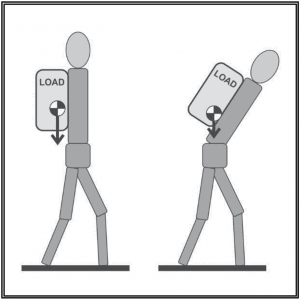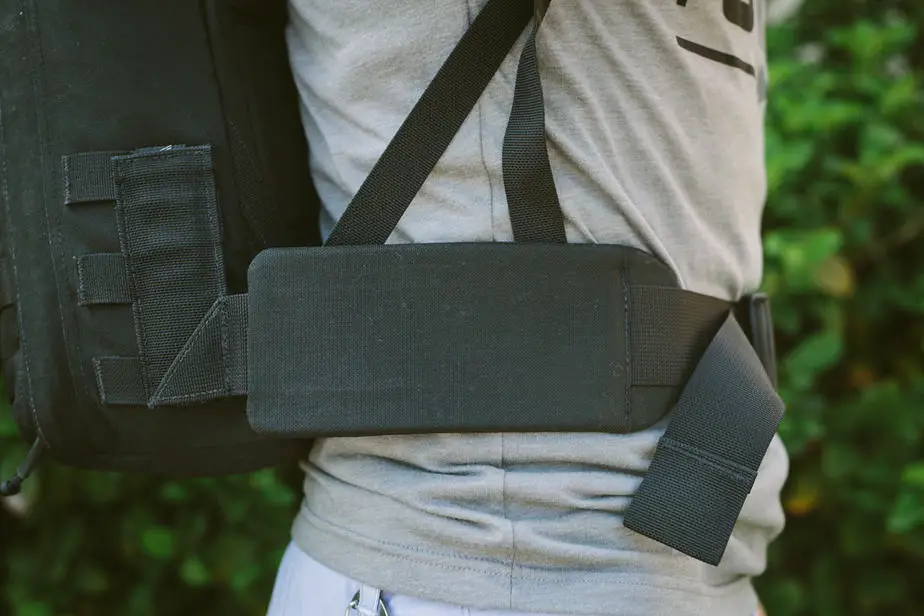
If you ruck with improper form, rucking is bad for your back. Constant compression from the straps can cause nerve compression injury. However, if you have proper posture, carry an appropriate weight load, and watch out for the compression caused by the straps, rucking is not bad for your back.
Carrying excessively heavy weight in your rucksack can lead to lower back pain, it increases the likelyhood of you getting injured. The same way body builders get injured when they lift more weight than they’re used to. This is because, naturally, the heavy weight forces you to lean forward when you ruck. This is known as Trunk Lean. A classic approach of carrying the heavy weight by leaning forward as an attempt to counterbalance the weight load.
Check out our guide on figuring out how much weight to carry when rucking, especially if you’re just starting out!
Back Pain From Shoulder straps When Rucking

Padded rucksacks that are not loose, not completely flexible, padded, and around 8cm wide are optimal to prevent back pain and compression nerve injury when rucking.
Proper shoulder straps go a long way to supporting your back, posture, and preventing pain.
A study published by PubMed (source) analyzed the difference between backpacks with shoulder straps vs non-flexible shoulder straps (typically seen on proper rucksacks) on participants’ normal gait (the way they walk). The study had some interesting findings on the impact of shoulder straps on the shoulders.
The particpants were first asked to wear the backpack with flexible shoulder straps and walk on a tradmill for 15 minutes, and again but with non-flexible shoulder straps. They looked at the impacts of both backpacks on the participants’ level of pain on their neck, shoulder, lumbar, upper and lower leg muscles. Shortly after, they filled out a questionnaire to report on the level of pain between both backpacks.
Results
The results from the questionnaire filled by the particpants showed that 75% of them claimed:
- Less neck muscle pain
- Less shoulder pain
- Less lower back pain
The results of the experiment also showed that their normail gait (the proper mechanics of walking) improved resulting in better posture. It also indicated that wider shoulder straps (8 chm is the optimal width) is best when carrying a havy load. This makes sense because there is better weight distribution on your shoulders. Paired with a padded shoulder strap and you’re golden. Learn more about how to avoid shoulder pain when rucking.
Importance of Maintaining Proper Posture – Tips & Tricks
With all that said, its important to make sure that you maintain proper posture when rucking to avoid back pain. In fact, according to the US Army Public Health Center (source), proper posture and utilizing the hip belt can reduce the load on your back by 30% and prevent back pain.

1. Use a Proper Rucksack
We do recommend using a Molle (Modular Lightweight Load-Carrying Equipment) rucksack. Especially if you’re in the military. This is because
- The main rucksack has a lightweight external frame
- Adjustable shoulder straps,
- Waist belt
- Several pockets and detachable compartments to allow unit-specific customization
Here’s our favourite MOLLE rucksack that encompasses all these features (link to amazon).
Unsure if your rucksack is not the right size for you? check out our recent post, is a 65 litre rucksack big enough.
2. Properly Adjust Your Straps
Make sure your shoulder strap is padded and well strapped. However while on the ruck, make sure your mindful of rubbing, or numbing sensation around your shoulders and adjust accordingly. Constant compression from straps can also cause nerve injury or blisters (source). If you do get to that stage, relax. Take a rest and adjust your belongings. Try to lighten the load if possible.
Here’s our complete list of the best rucksacks for rucking to help protect your back and help you maintain proper posture.
3. Use a Hip Belt

Use your hip belt! Hip belts hip distributes the weight proportiantly around your body and when used correctly, can take 30% of the load. It allows you to carry and move the weight with your legs, taking away the strain from your shoulders. Make sure they’re tight enough so that it is doing its job to keep the rucksack close to you, but not too tight that its uncomfortable.
Most military style rucksacks have external frames that also include hip belts, check out our best military rucksack with frames for more information.
4. Put Commonly Used Items in Front Pockets
This allows you to avoid having to take off and put on the rucksack a thousand times. It minimizes the load on your back, and allows for easy access to your belongings.
5. Place Belongings based on The Terrain
It is recommended to change the placements of your belonings based on the terrain you’ll be walking on:
| Flat Terrain | Place heavy items on top, to help you stay upright |
| Non-Flat Terrain | Aim to distribute weight as evenly as possible to help keep your body stable. |
Check out our top rucking tips for more rucking tips and check out our full list of rucking gear to ease up your ruck.
What Should I do If I Still Feel Back Pain When Rucking
1. Visit A Doctor
Visit a doctor. Its always the safest bet. The doctor may end up referring you to a professional physiotherapist who will work on any underlying issues.
2. Use A Weighted Vest
Second, you may want to consider using a weighted vest as an alternative to the rucksack. It could be a temporary adjustment, but a weighted vest could be a great alternative to a rucksack. This is because the weight is more centred to your body and you become less dependent on your back to carry the weight. It’s always best to consult with your doctor before trying the weighted vest if you currently or had a previous injury.
